Application of Convolutional Neural Network for Fingerprint-Based Prediction of Gender, Finger Position, and Height
Abstract
:1. Introduction
2. Materials and Methods
2.1. Data Collection
2.2. Image Preprocessing
2.3. Establishment of Deep Learning Model
2.4. Grad-Cam Image Analysis and Experts’ Prediction
3. Results
3.1. Gender Prediction
3.2. Prediction of Left- or Right-Hand Fingerprints
3.3. Prediction of Finger Position
3.4. Prediction of Height Range
3.5. Expert Prediction and Grad-CAM Image Analysis Results
4. Discussion
5. Conclusions
Supplementary Materials
Author Contributions
Funding
Conflicts of Interest
References
- Karki, R.; Singh, P. Gender determination from fingerprints. J. Univ. Coll. Med. Sci. 2014, 2, 12–15. [Google Scholar] [CrossRef] [Green Version]
- Falsetti, A.B. Sex Assessment from Metacarpals of the Human Hand. J. Forensic Sci. 1995, 40, 774–776. [Google Scholar] [CrossRef] [PubMed]
- Badawi, A.M.; Mahfouz, M.; Tadross, R.; Jantz, R. Fingerprint-Based Gender Classification. IPCV 2006, 15, 41–46. [Google Scholar]
- Ramanjit, K.; Garg, R.K. Determination of Gender Differences from Fingerprint Ridge Density in Two Northern Indian Populations. Probl. Forensic Sci. 2011, 85, 5–10. [Google Scholar]
- Tom, R.J.; Arulkumaran, T.; Scholar, M.E. Fingerprint based gender classification using 2D discrete wavelet transforms and principal component analysis. Int. J. Eng. Trends Technol. 2013, 4, 199–203. [Google Scholar]
- Gornale, S.S.; Geetha, C.D.; Kruthi, R. Analysis of fingerprint image for gender classification using spatial and frequency domain analysis. Am. Int. J. Res. Sci. Technol. Eng. Math. 2013, 1, 46–50. [Google Scholar]
- Kaur, R.; Mazumdar, S.G. Mazumdar, and Technology, Fingerprint based gender identification using frequency domain analysis. Int. J. Adv. Eng. Technol. 2012, 3, 295. [Google Scholar]
- Rajesh, D.G.; Punithavalli, M. An efficient fingerprint based gender classification system using dominant un-decimated wavelet coefficients. Res. J. Appl. Sci. Eng. Technol. 2014, 8, 1259–1265. [Google Scholar] [CrossRef]
- Gnanasivam, P.; Muttan, D.S. Fingerprint gender classification using wavelet transform and singular value decomposition. arXiv 2012, arXiv:1205.6745. [Google Scholar]
- Shehu, Y.I.; Ruiz-Garcia, A.; Palade, V.; James, A. Detailed identification of fingerprints using convolutional neural networks. In Proceedings of the 2018 17th IEEE International Conference on Machine Learning and Applications (ICMLA), Orlando, FL, USA, 17–20 December 2018. [Google Scholar]
- Kim, J.; Beanbonyka, R.; Sung, N.-J.; Hong, M. Left or Right Hand Classification from Fingerprint Images Using a Deep Neural Network. Comput. Mater. Contin. 2020, 62, 17–30. [Google Scholar] [CrossRef]
- Rim, B.; Kim, J.; Hong, M. Fingerprint classification using deep learning approach. Multimedia Tools Appl. 2021, 80, 35809–35825. [Google Scholar] [CrossRef]
- Simonyan, K.; Zisserman, A. Very deep convolutional networks for large-scale image recognition. arXiv 2014, arXiv:1409.1556. [Google Scholar]
- Szegedy, C.; Liu, W.; Jia, Y.; Sermanet, P.; Reed, S.; Anguelov, D.; Erhan, D.; Vanhoucke, V.; Rabinovich, A. Going deeper with convolutions. In Proceedings of the IEEE Conference on Computer Vision and Pattern Recognition (CVPR), Boston, MA, USA, 7–12 June 2015. [Google Scholar]
- He, K.; Zhang, X.; Ren, S.; Sun, J. Deep residual learning for image recognition. In Proceedings of the IEEE Conference on Computer Vision and Pattern Recognition, Las Vegas, NV, USA, 27–30 June 2016. [Google Scholar]
- Selvaraju, R.R.; Cogswell, M.; Das, A.; Vedantam, R.; Parikh, D.; Batra, D. Grad-cam: Visual explanations from deep networks via gradient-based localization. In Proceedings of the IEEE International Conference on Computer Vision, Venice, Italy, 22–29 October 2017. [Google Scholar]
- Chattopadhay, A.; Sarkar, A.; Howlader, P.; Balasubramanian, V.N. Grad-cam++: Generalized gradient-based visual explanations for deep convolutional networks. In Proceedings of the 2018 IEEE Winter Conference on Applications of Computer Vision (WACV), Lake Tahoe, NV, USA, 12–15 March 2018. [Google Scholar]
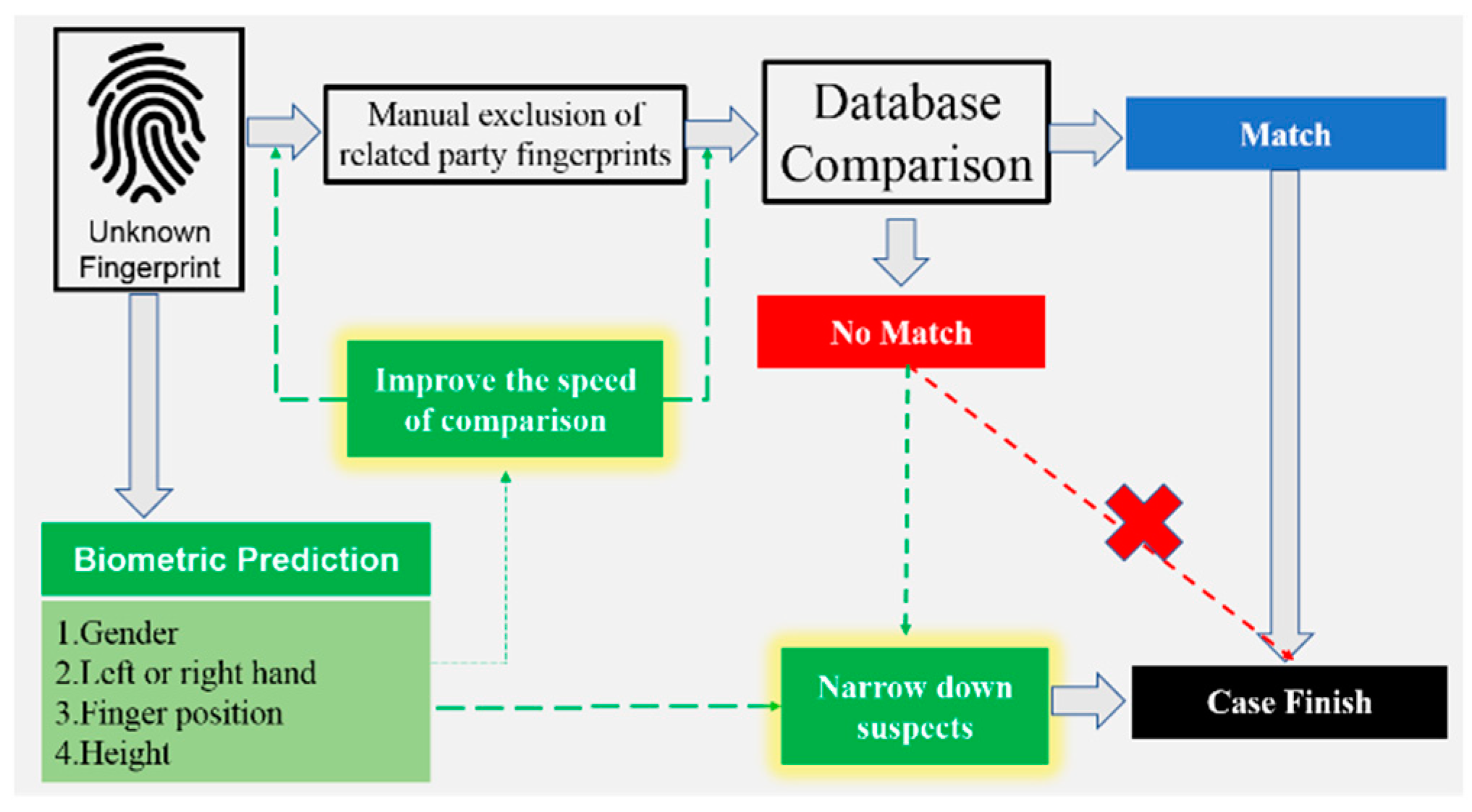
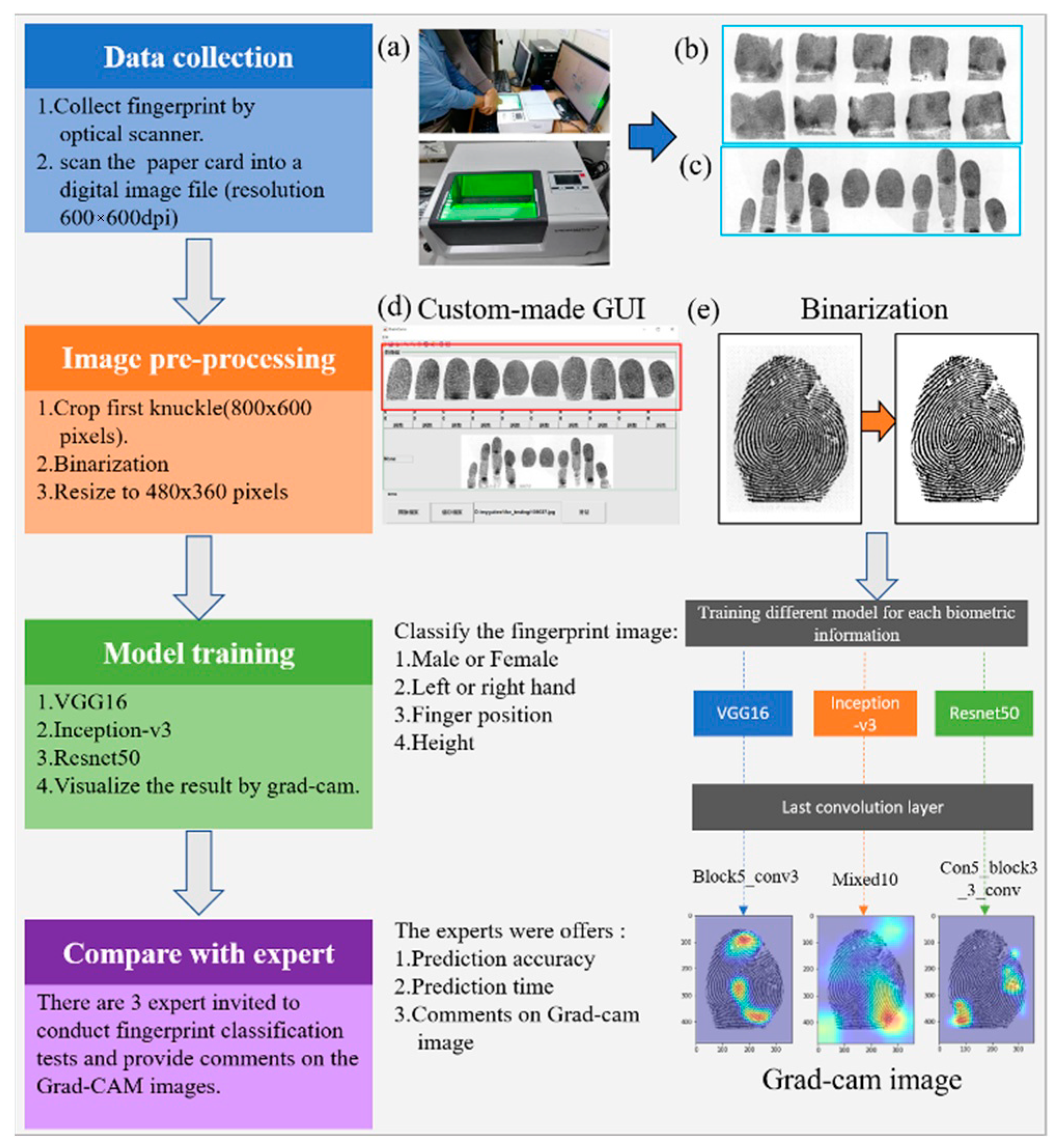
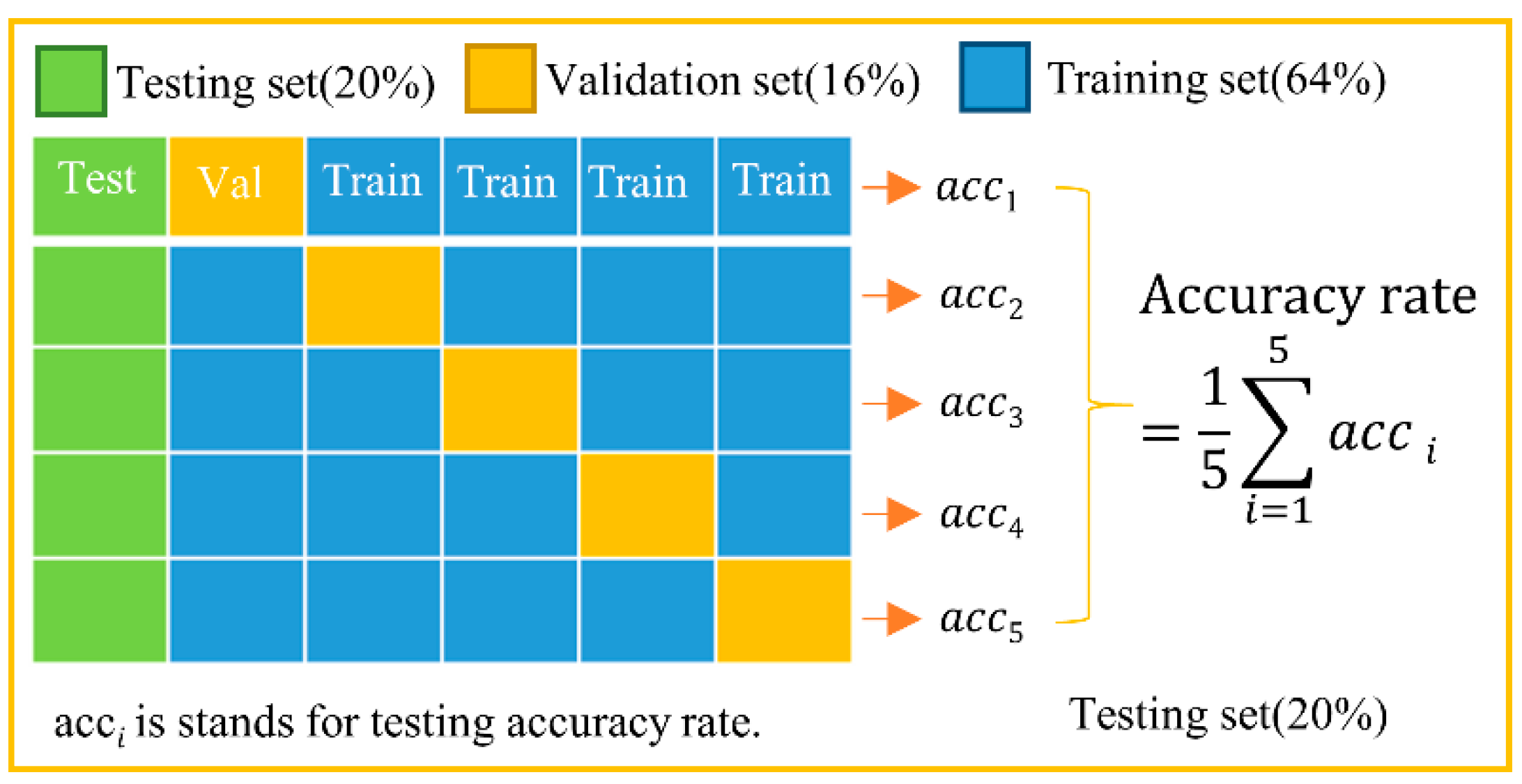
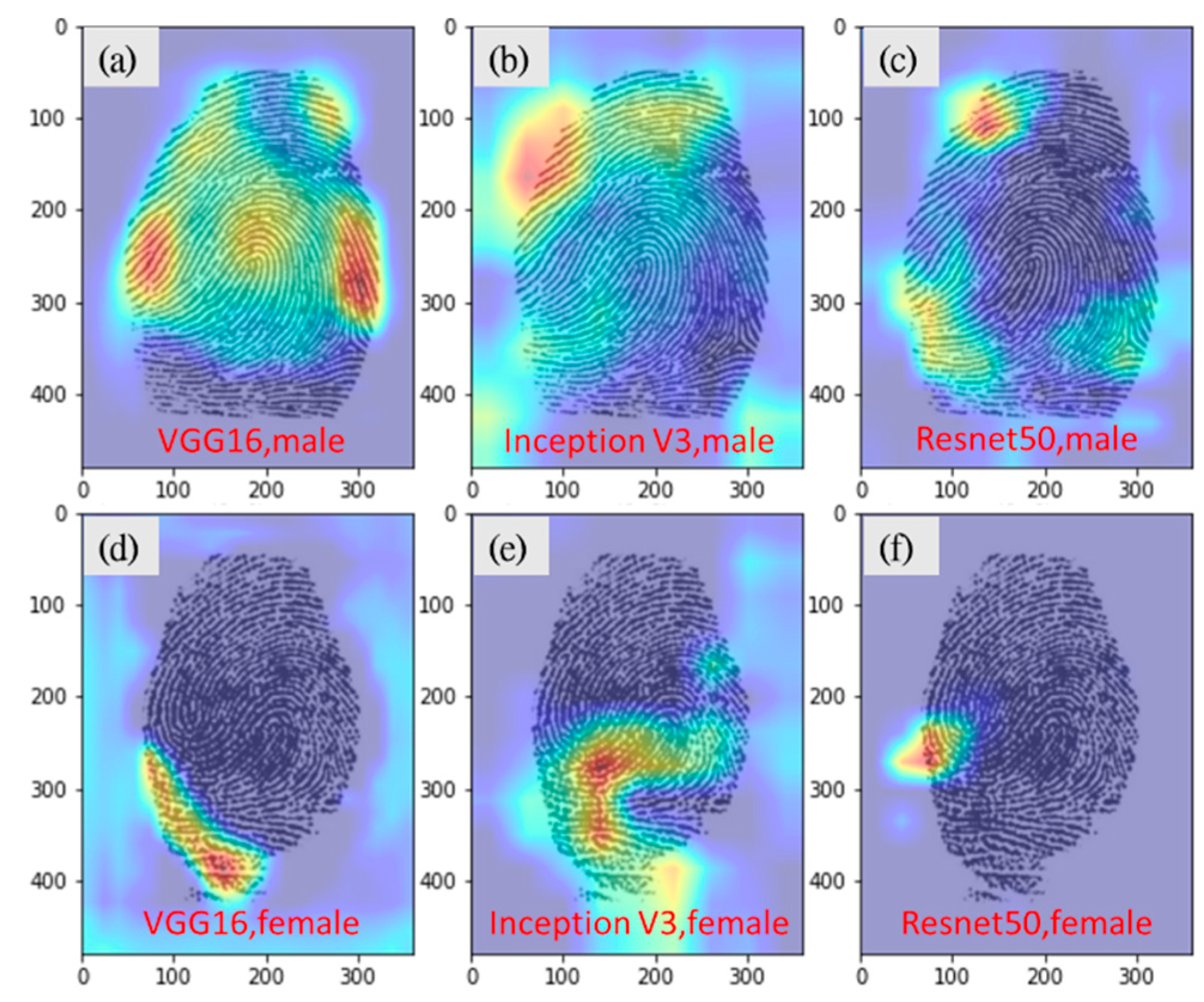
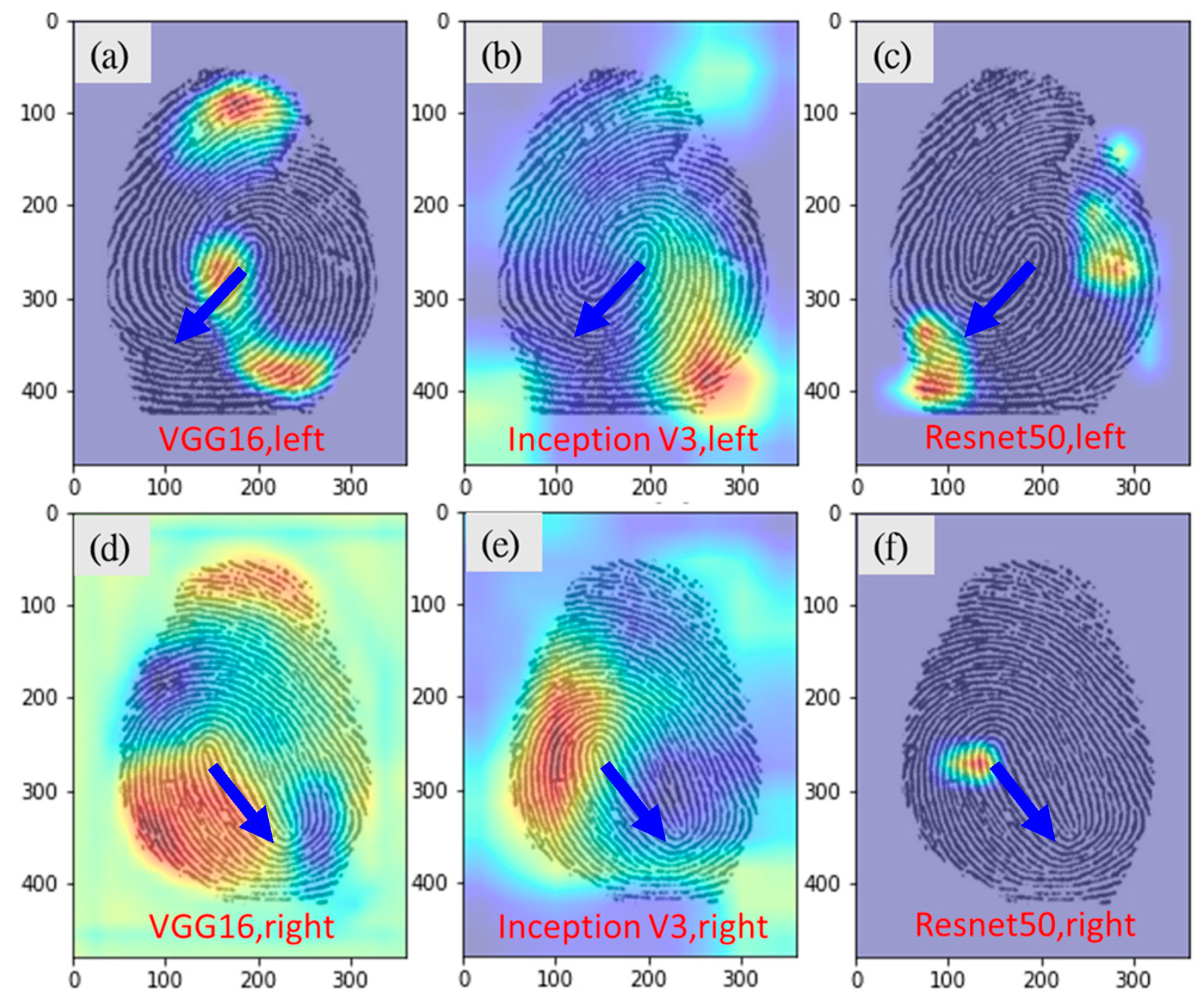
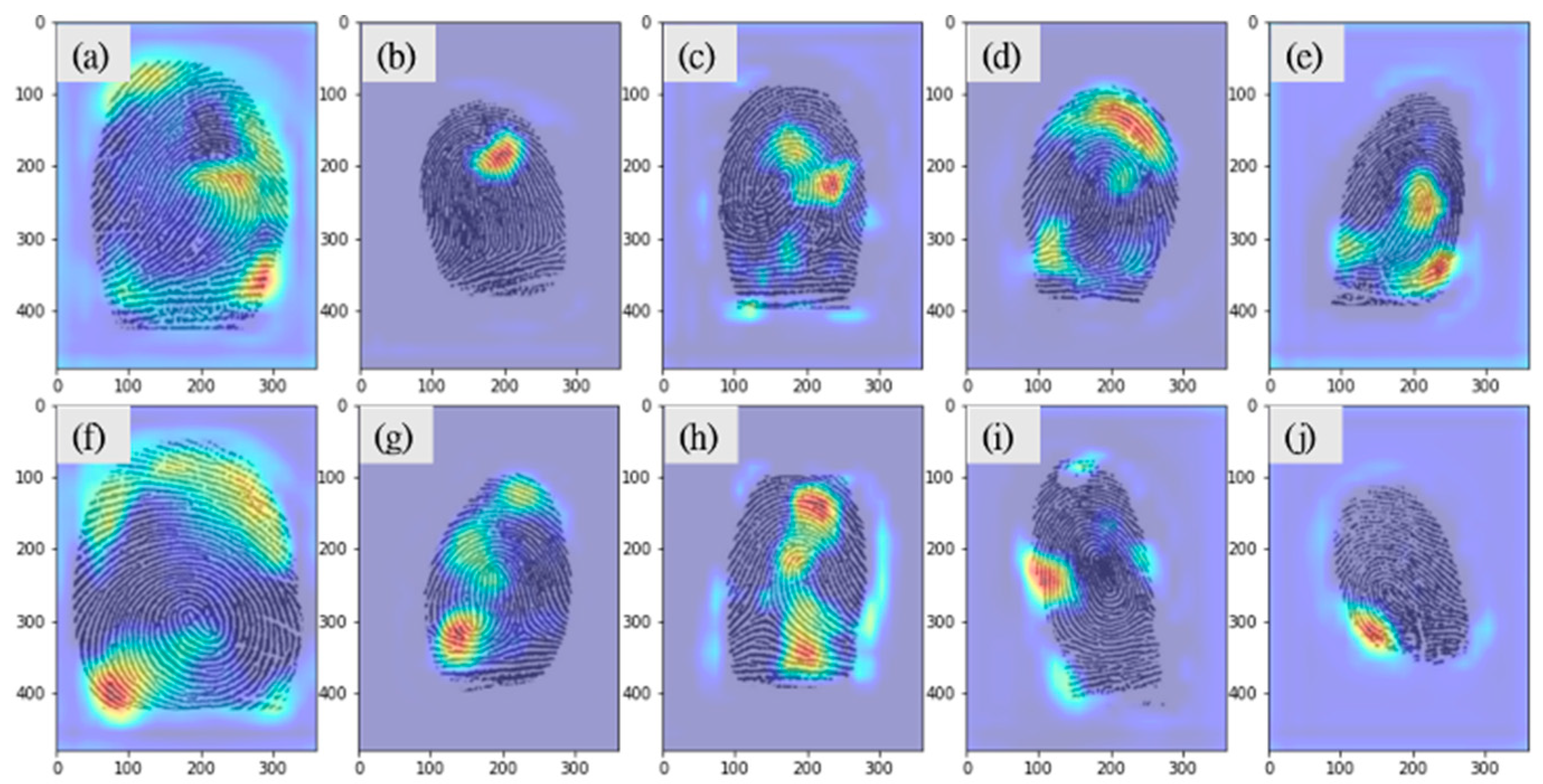
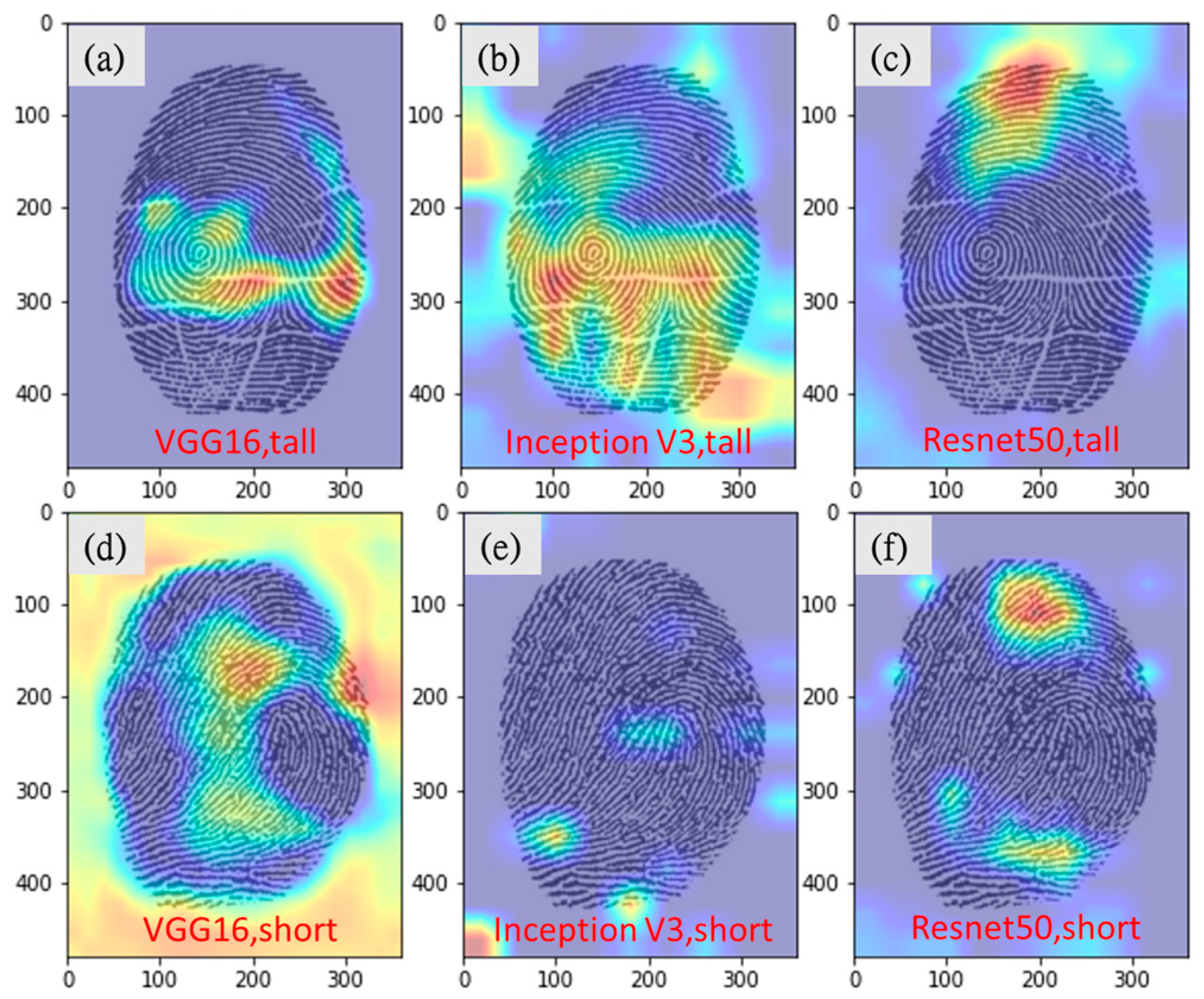

| Male | Female | ||
|---|---|---|---|
| Height | Counts | Height | Counts |
| 140–150 | 0 | 140–150 | 11 |
| 150–160 | 3 | 150–160 | 173 |
| 160–170 | 100 | 160–170 | 263 |
| 170–180 | 289 | 170–180 | 52 |
| 180–190 | 102 | 180–190 | 1 |
| 190–200 | 6 | 190–200 | 0 |
| Model | Male | Female | Accuracy (Mean ± STD) | ||
|---|---|---|---|---|---|
| Correct | Incorrect | Correct | Incorrect | ||
| VGG16 | 766.6 | 233.4 | 817.6 | 182.4 | 79.2 ± 1.2% |
| Inception-v3 | 774.8 | 225.2 | 767 | 233 | 77.1 ± 0.9% |
| Resnet50 | 793 | 207 | 789.6 | 210.4 | 79.1 ± 0.8% |
| Model | Left | Right | Accuracy (Mean ± STD) | ||
|---|---|---|---|---|---|
| Correct | Incorrect | Correct | Incorrect | ||
| VGG16 | 950.4 | 49.6 | 937.8 | 62.2 | 94.4 ± 0.5% |
| Inception-v3 | 917.6 | 82.4 | 916.6 | 83.4 | 91.7 ± 0.5% |
| Resnet50 | 928.8 | 71.2 | 944.6 | 55.4 | 93.7 ± 0.5% |
| Model | Left/Right | Thumb | Index | Middle | Ring | Little | Average Accuracy |
|---|---|---|---|---|---|---|---|
| VGG16 | Left | 96.5 ± 0.7% | 82.3 ± 3.0% | 79.3 ± 2.2% | 75.0 ± 3.0% | 86.0 ± 2.9% | 84.8% |
| Right | 95.5 ± 2.4% | 87.9 ± 3.8% | 81.8 ± 3.8% | 75.2 ± 3.4% | 88.4 ± 2.3% | ||
| Inception-v3 | Left | 94.2 ± 2.0% | 69.9 ± 4.1% | 67.9 ± 5.0% | 71.9 ± 3.7% | 80.5 ± 3.4% | 77.9% |
| Right | 93.6 ± 1.7% | 76.7 ± 5.4% | 71.8 ± 4.5% | 72.5 ± 5.0% | 80.1 ± 4.5% | ||
| Resnet50 | Left | 95.6 ± 1.3% | 80.9 ± 4.4% | 79.1 ± 2.8% | 70.8 ± 4.3% | 82.7 ± 3.3% | 83.9% |
| Right | 96.3 ± 3.0% | 82.9 ± 3.6% | 77.4 ± 5.6% | 79.5 ± 2.9% | 84.2 ± 2.2% |
| Model | Tall | Short | Accuracy (Mean ± STD) | ||
|---|---|---|---|---|---|
| Correct | Incorrect | Correct | Incorrect | ||
| VGG16 | 131.8 | 68.2 | 123.8 | 76.2 | 63.9 ± 4.1% |
| Inception-v3 | 124.2 | 75.8 | 131 | 69 | 63.8 ± 3.1% |
| Resnet50 | 113 | 87 | 141.8 | 58.2 | 63.7 ± 2.2% |
| Model | Tall | Short | Accuracy (Mean ± STD) | ||
|---|---|---|---|---|---|
| Correct | Incorrect | Correct | Incorrect | ||
| VGG16 | 123.4 | 76.6 | 126.4 | 73.6 | 62.5 ± 1.9% |
| Inception-v3 | 146.8 | 53.2 | 95.2 | 104.8 | 60.5 ± 2.3% |
| Resnet50 | 98.4 | 101.6 | 152.8 | 47.2 | 62.8 ± 3.6% |
| Expert | Male | Female | Accuracy | Time | ||
|---|---|---|---|---|---|---|
| Correct | Incorrect | Correct | Incorrect | |||
| A | 6 | 4 | 9 | 1 | 75.0% | 57 s |
| B | 6 | 4 | 6 | 4 | 60.0% | 85 s |
| C | 6 | 4 | 6 | 4 | 60.0% | 78 s |
| Average | 18 | 12 | 21 | 9 | 65.0% | 73.3 s |
| Expert | Left | Right | Accuracy | Time | ||
|---|---|---|---|---|---|---|
| Correct | Incorrect | Correct | Incorrect | |||
| A | 8 | 2 | 9 | 1 | 85.0% | 57 s |
| B | 8 | 2 | 9 | 1 | 85.0% | 62 s |
| C | 7 | 3 | 9 | 1 | 80.0% | 98 s |
| Average | 23 | 7 | 27 | 3 | 83.3% | 72.3 s |
| Expert | Correct | Incorrect | Accuracy | Time |
|---|---|---|---|---|
| A | 9 | 11 | 45.0% | 169 s |
| B | 6 | 14 | 30.0% | 131 s |
| C | 9 | 11 | 45.0% | 222 s |
| Average | 24 | 36 | 40.0% | 174 s |
| Male | |||||
|---|---|---|---|---|---|
| Model | Tall | Short | Accuracy (Mean ± STD) | ||
| Correct | Incorrect | Correct | Incorrect | ||
| VGG16 | 131.8 | 68.2 | 123.8 | 76.2 | 63.9 ± 4.1% |
| Inception V3 | 124.2 | 75.8 | 131 | 69 | 63.8 ± 3.1% |
| Resnet50 | 113 | 87 | 141.8 | 58.2 | 63.7 ± 2.2% |
| Female | |||||
| Model | Tall | Short | Accuracy (Mean ± STD) | ||
| Correct | Incorrect | Correct | Incorrect | ||
| VGG16 | 123.4 | 76.6 | 126.4 | 73.6 | 62.5 ± 1.9% |
| Inception V3 | 146.8 | 53.2 | 95.2 | 104.8 | 60.5 ± 2.3% |
| Resnet50 | 98.4 | 101.6 | 152.8 | 47.2 | 62.8 ± 3.6% |
Publisher’s Note: MDPI stays neutral with regard to jurisdictional claims in published maps and institutional affiliations. |
© 2022 by the authors. Licensee MDPI, Basel, Switzerland. This article is an open access article distributed under the terms and conditions of the Creative Commons Attribution (CC BY) license (https://creativecommons.org/licenses/by/4.0/).
Share and Cite
Hsiao, C.-T.; Lin, C.-Y.; Wang, P.-S.; Wu, Y.-T. Application of Convolutional Neural Network for Fingerprint-Based Prediction of Gender, Finger Position, and Height. Entropy 2022, 24, 475. https://doi.org/10.3390/e24040475
Hsiao C-T, Lin C-Y, Wang P-S, Wu Y-T. Application of Convolutional Neural Network for Fingerprint-Based Prediction of Gender, Finger Position, and Height. Entropy. 2022; 24(4):475. https://doi.org/10.3390/e24040475
Chicago/Turabian StyleHsiao, Chung-Ting, Chun-Yi Lin, Po-Shan Wang, and Yu-Te Wu. 2022. "Application of Convolutional Neural Network for Fingerprint-Based Prediction of Gender, Finger Position, and Height" Entropy 24, no. 4: 475. https://doi.org/10.3390/e24040475
APA StyleHsiao, C.-T., Lin, C.-Y., Wang, P.-S., & Wu, Y.-T. (2022). Application of Convolutional Neural Network for Fingerprint-Based Prediction of Gender, Finger Position, and Height. Entropy, 24(4), 475. https://doi.org/10.3390/e24040475





